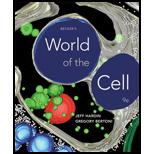
(a)
To determine: The total annual amount of incoming energy when it is assumed that the cross-sectional area of earth is 1.28 × 1018 cm2 and it is given that the energy arrives at the upper surface of Earth’s atmosphere at the rate of 1.94 cal/min/cm2 of the cross-sectional area.
Introduction: Solar energy is the prime source of energy for all the living organisms on Earth directly or indirectly. Photoautotrophic organisms capture this incoming energy from sunlight and convert it into biological energy forms. Heterotrophic organisms depend on these autotrophic organisms for the conversion of solar energy into biological energy. A large amount of solar energy reaches Earth’s surface but only a small fraction of it is converted for biological use. Out of the total amount of energy released by the sun, a very small portion of it reaches the Earth’s surface.
(b)
To explain: The fate of the energy, particularly in the wavelength ranges below 300 nm and above 80 nm, which do not reach the Earth’s surface.
Introduction: Solar energy is the prime source of energy for all the living organisms on Earth directly or indirectly. Photoautotrophic organisms capture this incoming energy from sunlight and convert it into biological energy forms. Heterotrophic organisms depend on these autotrophic organisms for the conversion of solar energy into biological energy. A large amount of solar energy reaches Earth’s surface but only a small fraction of it is converted for biological use. Out of the total amount of energy released by the sun, a very small portion of it reaches the Earth’s surface.
(c)
To explain: The low utilization efficiency of photosynthetically entrapping the radiations that reach the Earth’s surface.
Introduction: Solar energy is the prime source of energy for all the living organisms on Earth directly or indirectly. Photoautotrophic organisms capture this incoming energy from sunlight and convert it into biological energy forms. Heterotrophic organisms depend on these autotrophic organisms for the conversion of solar energy into biological energy. A large amount of solar energy reaches Earth’s surface but only a small fraction of it is converted for biological use. Out of the total amount of energy released by the sun, a very small portion of it reaches the Earth’s surface.
Want to see the full answer?
Check out a sample textbook solution
Chapter 5 Solutions
Becker's World of the Cell (9th Edition)
- Anwser these Discussion Questions: Part One Why were the plants kept in the dark prior to the experiment? Why is this important? Why is it important to boil the leaf? Explain why it was necessary to use boiling alcohol? What is the purpose of the iodine? Part Two What was the purpose of keeping the leaf in the dark and then covering it with a cardboard cut-out? What conclusions can you draw from this part of the lab? Part Three 7. In this experiment what was the purpose of adding the soda lime? 8. Why was a sealed bag placed around each plant? 9. What happened in the control plants? 10. What was the result on photosynthesis? Part Four 11. Why was a variegated leaf used in this experiment? !2. What conclusions can you draw about starch production in a variegated leaf?arrow_forwardHow did the color differences between the two bacterial species you used in this experiment help you determine if the streak plate method you performed was successful?arrow_forwardseries of two-point crosses were carried out among six loci (a, b, c, d, e and f), producing the following recombination frequencies. According to the data below, the genes can be placed into how many different linkage groups? Loci a and b Percent Recombination 50 a and c 14 a and d 10 a and e 50 a and f 50 b and c 50 b and d 50 b and e 35 b and f 20 c and d 5 c and e 50 c and f 50 d and e 50 d and f 50 18 e and f Selected Answer: n6 Draw genetic maps for the linkage groups for the data in question #5. Please use the format given below to indicate the genetic distances. Z e.g. Linkage group 1=P____5 mu__Q____12 mu R 38 mu 5 Linkage group 2-X_____3 mu__Y_4 mu sanightarrow_forward
- What settings would being able to isolate individual bacteria colonies from a mixed bacterial culture be useful?arrow_forwardCan I get a handwritten answer please. I'm having a hard time understanding this process. Thanksarrow_forwardSay you get AATTGGCAATTGGCAATTGGCAATTGGCAATTGGCAATTGGCAATTGGC 3ʹ and it is cleaved with Mspl restriction enzyme - how do I find how many fragments?arrow_forward
- Which marker does this DNA 5ʹ AATTGGCAATTGGCAATTGGCAATTGGCAATTGGCAATTGGCAATTGGC 3ʹ show?arrow_forwardThe Z value of LOD for two genes is 4, what does it mean for linkage and inheritance?arrow_forwardBiology How will you make a 50-ul reaction mixture with 2uM primer DNA using 10 uM primer DNA stocksolution and water?arrow_forward
 Human Physiology: From Cells to Systems (MindTap ...BiologyISBN:9781285866932Author:Lauralee SherwoodPublisher:Cengage Learning
Human Physiology: From Cells to Systems (MindTap ...BiologyISBN:9781285866932Author:Lauralee SherwoodPublisher:Cengage Learning Biology 2eBiologyISBN:9781947172517Author:Matthew Douglas, Jung Choi, Mary Ann ClarkPublisher:OpenStax
Biology 2eBiologyISBN:9781947172517Author:Matthew Douglas, Jung Choi, Mary Ann ClarkPublisher:OpenStax Biology Today and Tomorrow without Physiology (Mi...BiologyISBN:9781305117396Author:Cecie Starr, Christine Evers, Lisa StarrPublisher:Cengage Learning
Biology Today and Tomorrow without Physiology (Mi...BiologyISBN:9781305117396Author:Cecie Starr, Christine Evers, Lisa StarrPublisher:Cengage Learning Anatomy & PhysiologyBiologyISBN:9781938168130Author:Kelly A. Young, James A. Wise, Peter DeSaix, Dean H. Kruse, Brandon Poe, Eddie Johnson, Jody E. Johnson, Oksana Korol, J. Gordon Betts, Mark WomblePublisher:OpenStax College
Anatomy & PhysiologyBiologyISBN:9781938168130Author:Kelly A. Young, James A. Wise, Peter DeSaix, Dean H. Kruse, Brandon Poe, Eddie Johnson, Jody E. Johnson, Oksana Korol, J. Gordon Betts, Mark WomblePublisher:OpenStax College BiochemistryBiochemistryISBN:9781305577206Author:Reginald H. Garrett, Charles M. GrishamPublisher:Cengage Learning
BiochemistryBiochemistryISBN:9781305577206Author:Reginald H. Garrett, Charles M. GrishamPublisher:Cengage Learning





